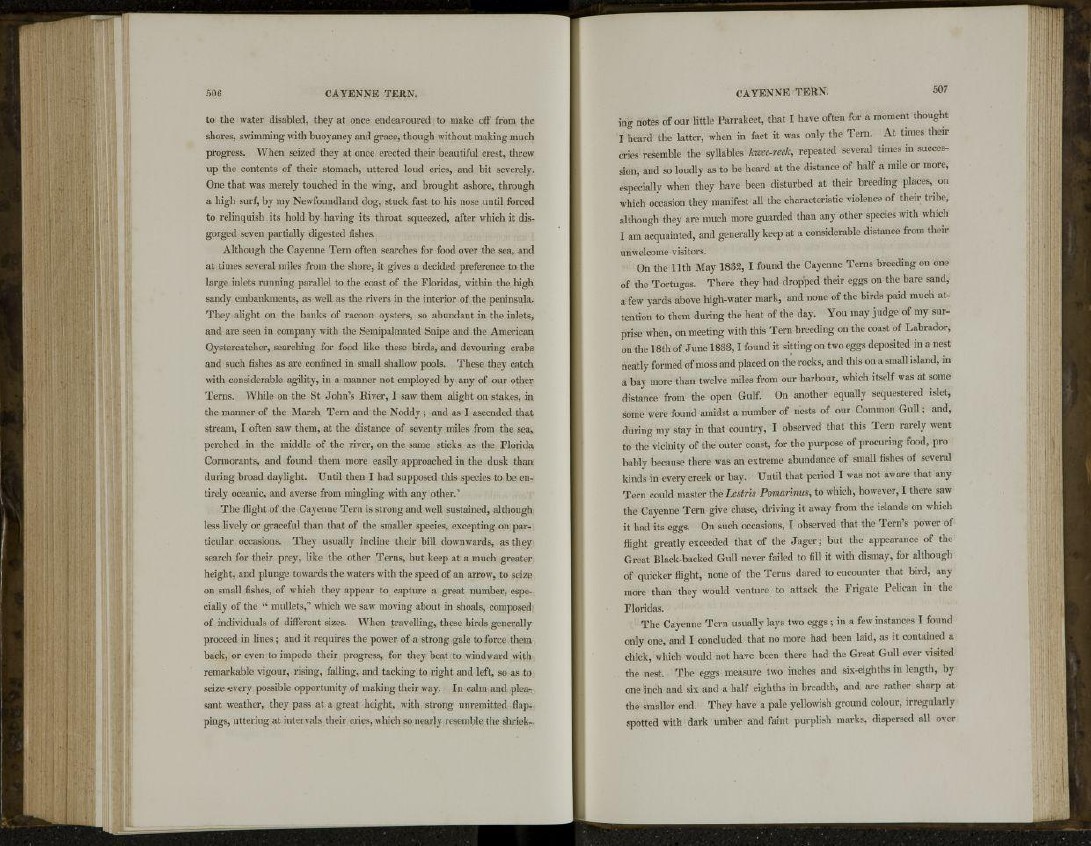
506 CAYENNE TERN.
to the water disabled, they at once endeavoured to make off from the
shores, swimming with buoyancy and grace, though without making much
progress. When seized they at once erected their beautiful crest, threw
up the contents of their stomach, uttered loud cries, and bit severely.
One that was merely touched in the wing, and brought ashore, through
a high surf, by my Newfoundland dog, stuck fast to his nose until forced
to relinquish its hold by having its throat squeezed, after which it disgorged
seven partially digested fishes.
Although the Cayenne Tern often searches for food over the sea, and
at times several miles from the shore, it gives a decided preference to the
large inlets running parallel to the coast of the Floridas, within the high
sandy embankments, as well as the rivers in the interior of the peninsula.
They alight on the banks of racoon oysters, so abundant in the inlets,
and are seen in company with the Semipalmated Snipe and the American
Oystercatcher, searching for food like these birds, and devouring crabs
and such fishes as are confined in small shallow pools. These they catch
with considerable agility, in a manner not employed by any of our other
Terns. While on the St John's River, I saw them alight on stakes, in
the manner of the Marsh Tern and the Noddy ; and as I ascended that
stream, I often saw them, at the distance of seventy miles from the sea,
perched in the middle of the river, on the same sticks as the Florida
Cormorants, and found them more easily approached in the dusk than
during broad daylight. Until then I had supposed this species to be entirely
oceanic, and averse from mingling with any other."
The flight of the Cayenne Tern is strong and well sustained, although
less lively or graceful than that of the smaller species, excepting on particular
occasions. They usually incline their bill downwards, as they
search for their prey, like the other Terns, but keep at a much greater
height, and plunge towards the waters with the speed of an arrow, to seize
on small fishes, of which they appear to capture a great number, especially
of the " mullets," which we saw moving about in shoals, composed
of individuals of different sizes. When travelling, these birds generally
proceed in lines; and it requires the power of a strong gale to force them
back, or even to impede their progress, for they beat to windward with
remarkable vigour, rising, falling, and tacking to right and left, so as to
seize -every possible opportunity of making their way. In calm and pleasant
weather, they pass at a great height, with strong unremitted flappings,
uttering at intervals their cries, which so nearly resemble the shriek-
CAYENNE TERN. 507
ing notes of our little Parrakeet, that I have often for a moment thought
I heard the latter, when in fact it was only the Tern. At times their
cries resemble the syllables kwee-reek, repeated several times in succession,
and so loudly as to be heard at the distance of half a mile or more,
especially when they have been disturbed at their breeding places, on
which occasion they manifest all the characteristic violence of their tribe,
although they are much more guarded than any other species with which
I am acquainted, and generally keep at a considerable distance from their
unwelcome visitors.
On the 11th May 1832, I found the Cayenne Terns breeding on one
of the Tortugas. There they had dropped their eggs on the bare sand,
a few yards above high-water mark, and none of the birds paid much attention
to them during the heat of the day. You may judge of my surprise
when, on meeting with this Tern breeding on the coast of Labrador,
on the 18th of June 1833,1 found it sitting on two eggs deposited in a nest
neatly formed of moss and placed on the rocks, and this on a small island, in
a bay more than twelve miles from our harbour, which itself was at some
distance from the open Gulf. On another equally sequestered islet,
some were found amidst a number of nests of our Common Gull; and,
during my stay in that country, I observed that this Tern rarely went
to the vicinity of the outer coast, for the purpose of procuring food, pro
bably because there was an extreme abundance of small fishes of several
kinds in every creek or bay. Until that period I was not aware that any
Tern could master the Lestris Pomarinus, to which, however, I there saw
the Cayenne Tern give chase, driving it away from the islands on which
it had its eggs. On such occasions, I observed that the Tern's power of
flight greatly exceeded that of the Jager; but the appearance of the
Great Black-backed Gull never failed to fill it with dismay, for although
of quicker flight, none of the Terns dared to encounter that bird, any
more than they would venture to attack the Frigate Pelican in the
Floridas.
The Cayenne Tern usually lays two eggs ; in a few instances I found
only one, and I concluded that no more had been laid, as it contained a
chick, which would not have been there had the Great Gull ever visited
the nest. The eggs measure two inches and six-eighths in length, by
one inch and six and a half eighths in breadth, and are rather sharp at
the smaller end. They have a pale yellowish ground colour, irregularly
spotted with dark umber and faint purplish marks, dispersed all over